Athletes Know No Boundaries
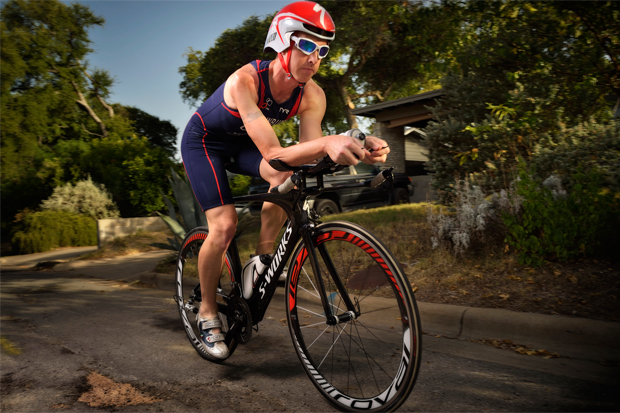
You’re an athlete. You love your sport. The people who encourage you and keep you going mean the world to you. Competing with other athletes or with your own record fuels your passion. Testing your limits and finding out what you’re made of drive your life. Sometimes you struggle to fit the training and the races, games, or other events into your work and family life, but you solve problems as they come along because you can’t imagine giving up your sport.
Would these statements still ring true for you if you lost your leg, your sight, or the use of your arm? Would they apply if you had been born into this kind of body? According to five athletes with physical challenges (and with close ties to Texas), the passion for their sport burns just as bright. Their supporters nestle in their hearts just as strongly. Competition urges them onward just as much. Challenging their alleged limits and staying true to themselves assumes an even greater role in their lives. For sure, the struggle to fit everything in becomes a major issue, but they solve problems, no matter how difficult, because they can’t imagine giving up their sport.
Meet Eduard Lychik, 22, a runner; Craig DeMartino, 47, a technical climber; Damon Clifford, 34, a runner and AFM FITTEST participant; Patricia Walsh, 32, a triathlete; and Joel Rosinbum, 32, a triathlete. Individually, these athletes radiate positive thinking and problem solving. Collectively, they generate enough passion, determination, can-do spirit, and sheer joy to inspire anyone. They may even make you want to try something that seems impossible.
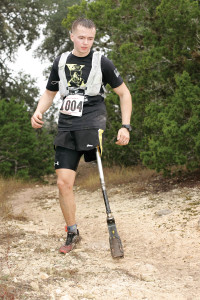 Eduard Lychik | 22, Runner
Eduard Lychik | 22, Runner
On September 30, 2011, enemy fire in Afghanistan blew away Eduard Lychik’s left leg. To save his life, surgeons had to remove his entire leg, all the way up to his hip socket. Within two months, he was working with his prosthetist, Bob Kuenzi, who designed, re-designed, and tinkered with an un-jointed leg atop a blade. Strapping it around his hips, Lychik learned to throw it forward with his core strength. Professionals at the Center for the Intrepid at the Brooke Army Medical Center in San Antonio doubted he could ever run again, but neither Lychik nor Kuenzi gave up. Lychik wanted to run.
A little over a year after his injury, on October 6, 2012, Lychik finished the Austin Tough Mudder obstacle course and, three months later, the Mid-Atlantic Super Spartan in Virginia. He credits his Team X-T.R.E.M.E. teammates and his Wounded Warrior friends for encouraging him to try these challenging events when half marathons on pavement just weren’t enough for him. Demonstrating this point beautifully, Lychik raced the Tejas Trails Bandera 25K trail run on January 12, 2013, in a time of 6:55:06, a respectable showing even for an athlete using his own two legs. It was a tough, muddy race with many difficulties to get through, as reported by Charles Seligman in TrailRunner. Lychik’s problem-solving skills and can-do determination got him to the finish line.
Lychik noted that his favorite post-injury race so far has been the Freescale Austin Marathon on February 17, 2013, because it’s his longest run to date. He covered the 26.2 hilly, humid miles in 4:33:03. His average pace of 10:25 minutes per mile may have been slower than his fastest pace of 8:15 or so in shorter, flatter runs, but it’s still a strong finishing time for a tough course.
Recently settling in Colorado Springs, CO, Lychik, who grew up in Tacoma, WA, hopes to make running his career now that he has retired from the military. He is also considering coaching runners, especially those with physical challenges. He admitted that his injury changed him from an active runner in high school to a much more serious athlete as an adult. No longer a shy teenager, he encouraged others not to set limits on themselves. Instead, he advised finding people who can help you. He’s a firm believer in never quitting, in trying “anything and everything just to find out what you can do.”
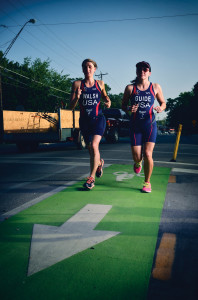 Patricia Walsh | 32, Triathlete
Patricia Walsh | 32, Triathlete
Patricia Walsh lost most of her vision at the age of 5 after surgery for a brain tumor. All but a six-degree field of vision was gone by her mid-teens. Multiple tests show that she is eligible to race in the International Triathlon Union (ITU) TRI6a category for the blind, despite several attempts to disqualify her and move her to a category for those with more sight. The TRI6b category is for those who are legally blind but still have up to a 40-degree field of vision.
Walsh, an engaging and warm-hearted electrical and computer engineer who recently moved to Austin from the Seattle area, continues to do most of her training on a bike trainer, in a pool, and on a treadmill so that she doesn’t have to “find a guide every single day.” For races, however, she must rely on a guide of the same sex and the same pace. During the swim and the run, a tether around her waist and the guide’s waist keeps her on course. A titanium tandem bicycle with the guide riding up front makes the bike course possible for her (as anyone who has ever ridden a tandem knows, the person pedaling in back has to work just as hard as—or harder than—the one in front). Stopping the bike and taking corners require more time than the same maneuvers on a single bike, so riding a tandem provides no advantage for Walsh. In fact, some might say there’s a disadvantage to riding a tandem; “divorce-cycle” is the common nickname among couples who use a tandem because riders who don’t communicate well on the bike encounter problems.
To show what a gifted athlete Walsh is, let’s look at her race times. At the 2013 Capital of Texas Paratriathlon on May 27, Walsh’s finishing time in the sprint distance was 1:18:12.13, earning first place in the TRI6a category, whereas the women’s 30-34 age group sprint winner finished in 1:18:26.74. At the Aquaphor New York City Triathlon on July 14, she won a prize of $1,500 for her first place time of 2:29:15 in the Olympic distance TRI6a category. The first- and second-place women’s 30-34 age groupers posted 2:09:01 and 2:26:25, respectively, symbolically giving Walsh third place. Walsh is the fastest blind female triathlete in America, and perhaps in the world. Though Walsh loves the Ironman distance and has raced several, she plans to continue to focus on shorter distances for now because the opportunities for international racing are more numerous.
The main challenges Walsh faces as a blind triathlete are her dependence on a guide and her time crunch issues. Since she generally uses a different guide for each race and meets the person only an hour or so before start time, she has found that communicating clearly is of utmost importance. An independent person, Walsh handles her transitions (between swim and bike, and between bike and run) without help and lets her guide know exactly what she needs and doesn’t need. Her “all-time favorite guide” is Austin’s own Angie Ballantine, who works full time at Jack & Adam’s Bicycles. Since Ballantine and her husband have a 6-year-old daughter, she can’t guide Walsh very often, but the two made the trip to the ITU World Championships in Auckland, New Zealand, in 2012, where Walsh earned a bronze medal. Ballantine called Walsh an “amazing athlete” and said that she thinks of her as a sister, a sentiment Walsh echoed.
Walsh, who has a full time job, also has her own side business, Blind Ambition Speaking, through which she books motivational speeches all over the U.S. With a day job, a side business, and her racing career, many of her time-crunch challenges center around transportation issues. But Walsh is a skilled problem solver, and she arrives where she needs to be on time, with very little help, and with all the necessary paraphernalia—and triathlon is a sport with much paraphernalia. She’ll be utilizing this skill set when she takes her gear overseas: Walsh is competing at the ITU Grand Final Championships in London on September 15 and will probably go to Rio de Janeiro in 2016 for the Paralympics (the ITU is still working on the start list).
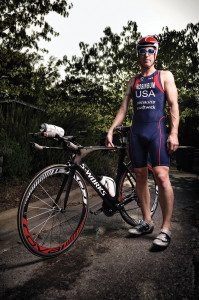 Joel Rosinbum | 32, Triathlete
Joel Rosinbum | 32, Triathlete
A rower in college and, afterward, a rowing coach, Joel Rosinbum has always been active, fitting his workouts in with his job as a software developer as best he could. Rosinbum had just started racing triathlons when he lost the use of his right arm in what could have been a potentially fatal skiing accident on March 2, 2007. He also broke eight ribs, punctured one lung, broke his shoulder blade in three places, and lost nearly all the sensation in his right arm. The injury was so profound that he considered having his arm amputated and replaced with a prosthetic limb. Subsequent surgeries, however, returned just enough sensation that he can prop his hand on the handlebar of his bike and achieve just enough grip strength to hang on. Rosinbum has no other use of the arm. He swims freestyle using only his left arm; he changes gears on his bike with only his left arm. On the run, he normally uses a sling to support his right arm to cut down on the jarring of constant impact.
Rosinbum and his wife Elizabeth married and moved to Austin about a year ago. Elizabeth, a music teacher specializing in the saxophone, doesn’t race triathlons herself. She has, however, mastered transition skills and is allowed into the transition area during Rosinbum’s races so she can perform the few tasks he can’t. The two met after Rosinbum’s accident, and Elizabeth noted with a warm smile when asked about her role as transition assistant that she “signed up for this.” How exactly does she assist? Although Rosinbum can change his shoes and put on his sling, Elizabeth will help him strip off his wetsuit (when the water temperature is cold enough to allow wearing a wetsuit), hand him his sunglasses and helmet (and fasten it properly), and place his bike on or off the rack as needed. They work together like a well-oiled machine, so “it’s all business—there’s no chit chat.” Among all categories of paratriathletes, Rosinbum holds the record for quickest transitions.
At the Capital of Texas Paratriathlon on Memorial Day, Rosinbum finished second in the TRI4 category (for those with any type of arm impairment) in a time of 1:13:03.09. He hopes he will get to compete at the Paralympics in Rio de Janeiro in 2016. Like Patricia Walsh, however, he must wait for the ITU to decide on the categories in which paratriathletes can compete. Currently, there are seven categories but the ITU plans to collapse them into only three. Some paratriathletes won’t qualify the way they usually do or will have to race against athletes in categories they don’t usually face, and some are bound to be disappointed by these developments. Whatever is decided about the 2016 Paralympics, Rosinbum, like Walsh, has his spot secured for the ITU World Championships in London.
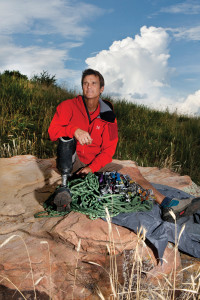 Craig DeMartino | 47, Technical Climber
Craig DeMartino | 47, Technical Climber
Craig DeMartino loved climbing. With over a dozen years of experience in such difficult, technical ascents as the 3,000-foot big wall of El Capitan in Yosemite National Park, DeMartino had never been injured and had never felt fear. Suddenly, on July 2, 2002, one of these things changed: He sustained massive injuries. Because of a miscommunication, his climbing partner accidentally dropped him, and DeMartino fell hard and fast for more than 100 feet. His back, ribs, and feet were broken. His shoulders, heart, lungs, liver, and kidneys were damaged. After a few moments of confusion and initial shock, DeMartino and his climbing partner set about solving a nightmarish problem and got DeMartino the help he needed.
Against all odds, DeMartino survived and thrived throughout numerous surgeries, including having his right leg amputated below the knee. The fall almost killed him, but it didn’t scare him away from his love of climbing. Although he still contends with chronic pain from nerve damage, DeMartino climbs every chance he gets. He has won five gold medals in climbing events at the Extremity Games, an annual competition similar to the X Games but designed for people without the use of one or more of their extremities. In October 2012, he won the Roger McCarville Male Athlete of the Year award at the Athletes with Disabilities Network Hall of Fame ceremony in Detroit.
DeMartino credited his wife Cyndy, 40, for much of his post-injury success. He called her “a great sounding board” and said she keeps him “sane.” They met while climbing almost two decades ago and still climb together all the time, although she doesn’t climb the highest walls. Their favorite date night is climbing 800 to 1,000 feet near their home in Loveland, CO, and going for burritos afterwards. In July, they climbed short cliffs in British Columbia and scouted big walls for Craig to conquer. In September, they will be at Half Dome in Yosemite. They plan to return to Hueco Tanks State Park and Historic Site near El Paso, TX, one of their favorite winter venues for bouldering (or climbing without ropes) this February. “If you love the outdoors,” DeMartino noted, but suddenly think your climbing life is gone for good, it’s particularly “sweet getting back to it.”
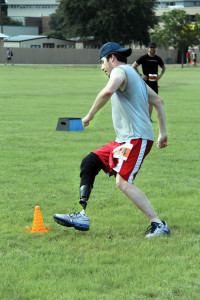 Damon Clifford | 34, AFM FITTEST Competitor
Damon Clifford | 34, AFM FITTEST Competitor
A multisport athlete in running, cycling, paratriathlon, and the AFM FITTEST, Clifford had his right leg amputated below the knee in June 2011 after suffering years of pain resulting from a car accident. In paratriathlon, he races in the Tri5 category for those with lower leg impairment. But, at the AFM FITTEST on June 15, 2013, he stood with athletes without physical challenges, as there were no separate categories for people who had lower leg impairment in this event. Clifford relished the competition, and explained that, “I really enjoy competing against able-bodied people because it reminds me that, no matter what physical disability I may have, I’m only as disabled as I think I am.”
Clifford posted his best scores in the Hand Grip (13th place), the Precision Throw (18th place), and Burpees (55th place). In none of the 12 events did he rank in last place, and he was part of one of the most competitive age divisions, Male 30–39, which had 61 participants. Clifford’s pace for the One-Mile Run was a respectable 9:12. As the only participant with a disability in the entire contest, he enjoyed the uniquely Austin event, calling the atmosphere “energizing, outgoing, and most importantly, supportive.”
Like other athletes with a prosthetic limb, Clifford has to work harder on logistics and time management than athletes without disabilities do. He also has to make sure he has the correct prosthesis for each sport he engages in. For example: A running prosthetic leg is different from a cycling prosthetic leg. Since he doesn’t always have a friend or family member at multisport events to help change out his leg, he noted that the volunteers at races and events have never failed to help if he has needed assistance. Clifford hasn’t found anything to stop him from competing, and the Austin resident appreciates the many opportunities that athletes of all abilities can enjoy here.
Common Themes
True athletes of all ages and abilities love their sport and the people who help them. No matter how tough a competition becomes, they retain their passion for sport and for life. Perhaps more so than most, athletes with physical challenges actively test their limits in order to find out what they can do. Logistics and time management may be more difficult, but they work hard to fit the training and competitions into their work and family life. They solve problems efficiently because they can’t imagine giving up. They compete because they love their sport. If they inspire someone along the way, that’s just lagniappe, but it’s not why they strive. They compete because they love it…and because they can. Long may they race.
Preparing Bodies and Minds for the 2014 Paralympic Games
Did you know that over 4,302 athletes took part in the London 2012 Paralympic Games? First held in Sweden in 1976, the Paralympic Games take place every four years in conjunction with the Olympic Games. Since ’88 and ’92, the summer and winter Paralympics have utilized the same facilities as the Olympics, with both sets of athletes representing their countries: mingling, competing, and enjoying the world’s best in athletic achievement and facilities.
In preparation for the 2014 Olympic Winter Games in Sochi, Russia, the Olympic Organizing Committee (OOC) has launched a program “to help shape the right attitudes towards people with disabilities, and to provide information about the history, philosophy and values of the Paralympic Movement.” The program was launched in response to a study finding that Russians have a low level of disability awareness—as well as awareness of the Paralympic Games themselves.
The OOC’s awareness program utilizes several approaches:
• Accessibility Map Portal: This interactive map lists resources and sports clubs for people with disabilities. “Barrier-free” venues are also included.
• “Our Champions”: Celebrating past and present Paralympic champions from various federal districts in Russia, this program brings attention to their amazing physical feats and familiarizes Russians with their accomplishments.
• Paralympic Education: Designed to foster positive and welcoming attitudes, this unique program has already been integrated into Russian school curricula. In this initiative, Paralympic sport is celebrated as a way of enriching the lives of those with disabilities and shares the values and philosophy of the Paralympic movement.
In spite of progress made over the years, there is still much work to be done in raising awareness and acceptance of people who have disabilities. With the OOC’s efforts to educate the public, it is likely that great strides will be made toward providing a positive experience for both athletes and their fans during the 2014 Paralympic Games.
Learn more about these competitors; visit the following websites:
Discover more about Eduard Lychik’s early recovery from his devastating injury at
search.ivanhoe.com/channels/p_channelstory.cfm?storyid=30784;
to see the story about the Bandera 25K, go to trailrunnermag.com/component/content/article/522-wounded-warrior-tackles-bandera-25k
For more on Craig DeMartino’s accident and recovery, read his book, After the Fall: A Climber’s True Story of Facing Death and Finding Life, with coauthor Bill Romanelli (Kregel Publications, 2013)
Visit Damon Clifford’s website at www.damonclifford.com
Learn more about Blind Ambition, Patricia Walsh’s speaking business, at www.blindambitionspeaking.com
Get to know Joel Rosinbum through his blog, leftarmbandit.org, which is subtitled “Adventures of a brachial plexus Para triathlete.”






